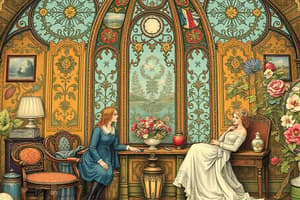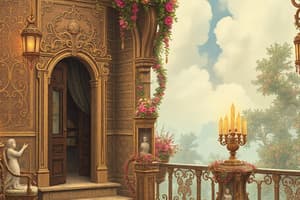Podcast
Questions and Answers
What term is credited to Pierre-Maurice Quays?
What term is credited to Pierre-Maurice Quays?
- Le style moderne
- Le style rocaille
- Le gout
- Rococo (correct)
What is a characteristic feature of Rocaille?
What is a characteristic feature of Rocaille?
- Inclusion of metallic materials
- Modeling on natural elements (correct)
- Use of dark colors
- Inclusion of geometric patterns
What period marked the shift from grandeur to relaxation and pleasure?
What period marked the shift from grandeur to relaxation and pleasure?
- Beginning of the 18th century
- End of the 17th century (correct)
- 17th century
- 18th century
What type of ornaments were used in Rococo design?
What type of ornaments were used in Rococo design?
Who is credited with introducing chinoiserie in Rococo design?
Who is credited with introducing chinoiserie in Rococo design?
What type of craftsmen specialized in veneering?
What type of craftsmen specialized in veneering?
Who is a notable architect and decorator of the Rococo period?
Who is a notable architect and decorator of the Rococo period?
What stylistic period of Rococo spanned from 1700-1730?
What stylistic period of Rococo spanned from 1700-1730?
What is the primary focus of Convenance in space planning?
What is the primary focus of Convenance in space planning?
Which room is at the center of a sequence of rooms in the main residence?
Which room is at the center of a sequence of rooms in the main residence?
What is the primary characteristic of Appartement de commodity?
What is the primary characteristic of Appartement de commodity?
Which of the following is NOT a room found on the ground floor of the Hotel de Janvry?
Which of the following is NOT a room found on the ground floor of the Hotel de Janvry?
What is the stylistic progression of Régence?
What is the stylistic progression of Régence?
Who worked with Jean Berain and became the source for the dissemination of grotesques and arabesque ornaments?
Who worked with Jean Berain and became the source for the dissemination of grotesques and arabesque ornaments?
What is the term for the group of rooms including a vestibule, anteroom, salone, and a chamber?
What is the term for the group of rooms including a vestibule, anteroom, salone, and a chamber?
What is the primary focus of Bienseance in space planning?
What is the primary focus of Bienseance in space planning?
Flashcards are hidden until you start studying
Study Notes
French Rococo (1700-1760)
- French terms for the style: "le style rocaille", "le style moderne", "le gout"
- Coined by Pierre-Maurice Quays, a French Neoclassical painter
Rocaille Features
- Modeled on nature: shells, pebbles, cascades of leaves and flowers, palm, fern, and coral forms
Historical Settings
- Shift from formality and flamboyance of Louis XIV's reign to relaxation and pleasure in the 18th century
- Resulted in smaller, more intimate apartments and softer ornamental styles
Characteristics
- Exclusive to the court, aristocracy, and nouveau riches from 1700-1775
- Divided into three stylistic periods: Regence (1700-1730), Louis XV (1730-1765), and Transitional Louis XV-XVI (1765-1775)
Influential People
- Jean I. Berain: introduced chinoiserie and singeries, and initiated the Rococo movement
- Jean Antoine Watteau: painter
- Gilles Marie Oppenord: architect and decorator
- Jean Bernard Toro: wood carver
- Jean Courtonne: designer of Hotel de Matignon
- Jaques-Francois Blondel: minor architect and academic theorist
- Jean Baptiste Alexandre Le Blond: recommended room composition in Parisian residences
- Nicolas Pineau: French carver, sculptor, and decorator who worked on the cabinet of Peter the Great
- Mathieu Criaerd: prominent cabinet maker
- Francois Boucher: French painter, draughtsman, and etcher known for classical themes
Spatial Relationships
- Three influential theories in space planning for architects: Convenance, Bienseance, and Commodite
- Convenance focuses on functional relationships between parts of the plan, separating public and private spaces
- Bienseance relates to the intended function or purpose of a space
- Commodite ensures the fullest utilization of space
Residential
- Main residence kept a distance from the cuisine (kitchen) and salle à manger (dining room)
- Vestibule (portico) features a flat vault with a 16-inch rise
- Vestibule and salone (sitting room) form the center of a sequence of rooms
- Appartement de parade: a group of rooms including vestibule, anteroom, salone, and chambre de parade
- Appartement de commodity: less formal, designed for comfort and easy heating
Floor Plans
- Ground Floor: vestibule, antechamber, salone, chamber à coucher, cabinet, escalier, salle du commun, cuisines, cour, cabinet du bibliotheque, passage, remises, cour, salle à manger, garderobe, chambre du jardinier
- First Floor (right): pallier, antichamber, chambre, cabinet, chambre pour domestiques, chambre, cabinet, arriere cabinet, chambre, cour, corridor
Interior Architecture and Decoration
- Régence style: influenced by King Louis XIV, characterized by formal to informal, relaxed, and asymmetrical designs
- Engravings of Jean Berain introduced changes in chimney piece designs, leading to the widespread use of chinoiserie and singeries
- Claude Audran III worked with Berain, disseminating grotesques and arabesque ornaments
- Features that anticipated the Rococo style: large mirrors, depressed arches, gold-highlighted cross-hatching, cartouches, and trophies
- Louis XV style: ornaments extended beyond panel frames, often highlighted in gold
- Genre pittoresques (picturesque style) was significant in Jean Aubert's work
- Materials and decorative techniques: terracotta, wood, marble, carved boiserie, fresco, verni martin, japanning, and relief design in plaster and gilt
Studying That Suits You
Use AI to generate personalized quizzes and flashcards to suit your learning preferences.




